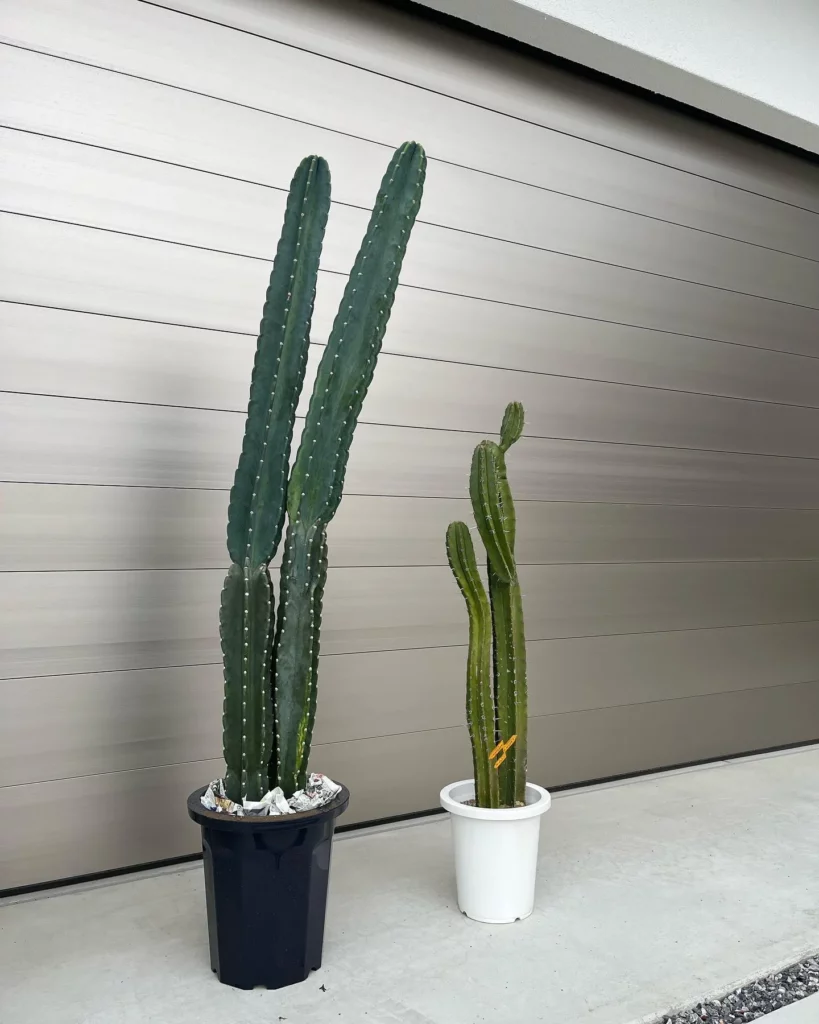The Dwarf Butterfly Agave is a visually striking plant with unique features that make it a standout addition to any garden or container. Its narrow leaves grow in a rosette shape, forming a small and compact plant. The leaves themselves are powder blue in color, giving them a soft and delicate appearance.
Key Takeaways:
- Dwarf Butterfly Agave is a miniature, compact plant that grows to one foot tall and wide.
- It has powder blue leaves with prominent dark red teeth and a red terminal spine.
- It thrives in small beds, cactus and succulent gardens, rock gardens, and mixed planters with other low-water-use plants.
- The Dwarf Butterfly Agave prefers filtered sun or full shade conditions and is tolerant of salty air and soils.
- It is drought-resistant and should be watered infrequently, allowing the soil to dry out between waterings.
Appearance of Dwarf Butterfly Agave
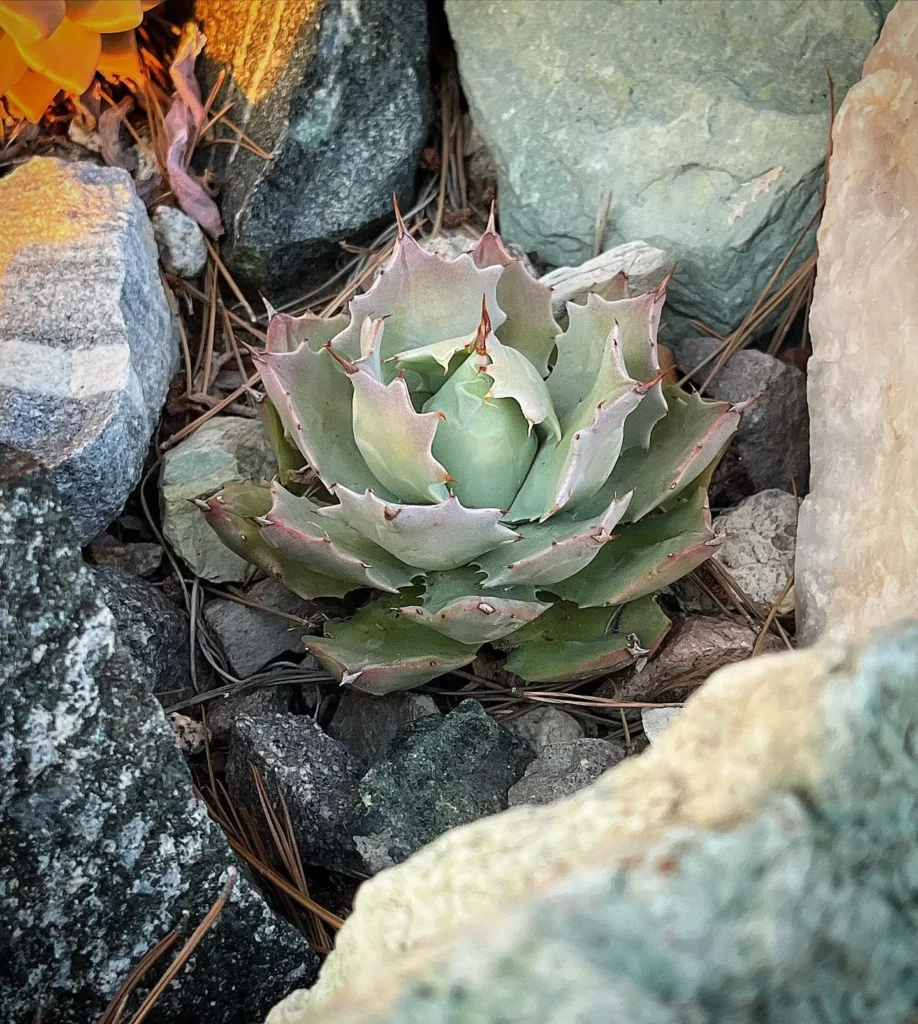

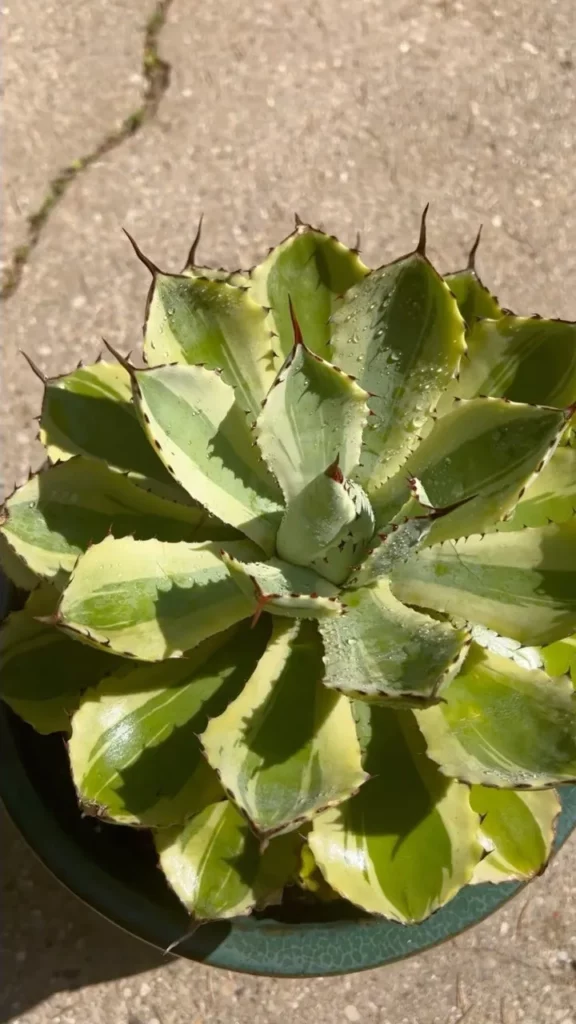
One of the most distinctive characteristics of the Dwarf Butterfly Agave is the prominent dark red teeth that line the margins of its leaves. These teeth add a touch of drama and contrast to the overall look of the plant. At the tip of each leaf, there is a red terminal spine, which completes the agave’s striking aesthetic.
Growth and Maturity
As the Dwarf Butterfly Agave matures, it develops a tall candelabra flower stalk, which can reach impressive heights. This flower stalk is adorned with beautiful yellow blooms, adding a vibrant burst of color to the plant. The combination of the blue leaves, red teeth, and yellow blooms creates a visually appealing spectacle that draws attention and admiration.
The compact size and stunning appearance of the Dwarf Butterfly Agave make it a versatile choice for both indoor and outdoor spaces. Whether used as a focal point in a rock garden or as a statement piece in a container, this plant is sure to captivate with its unique beauty.
Light Requirements for Dwarf Butterfly Agave
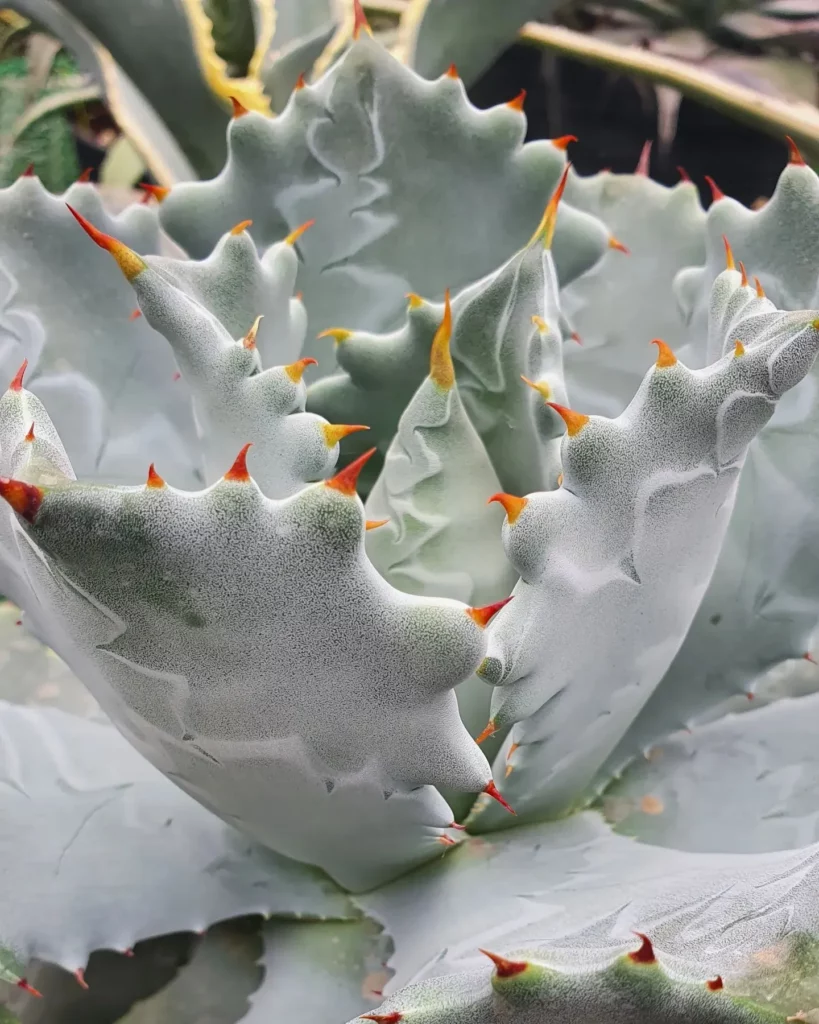
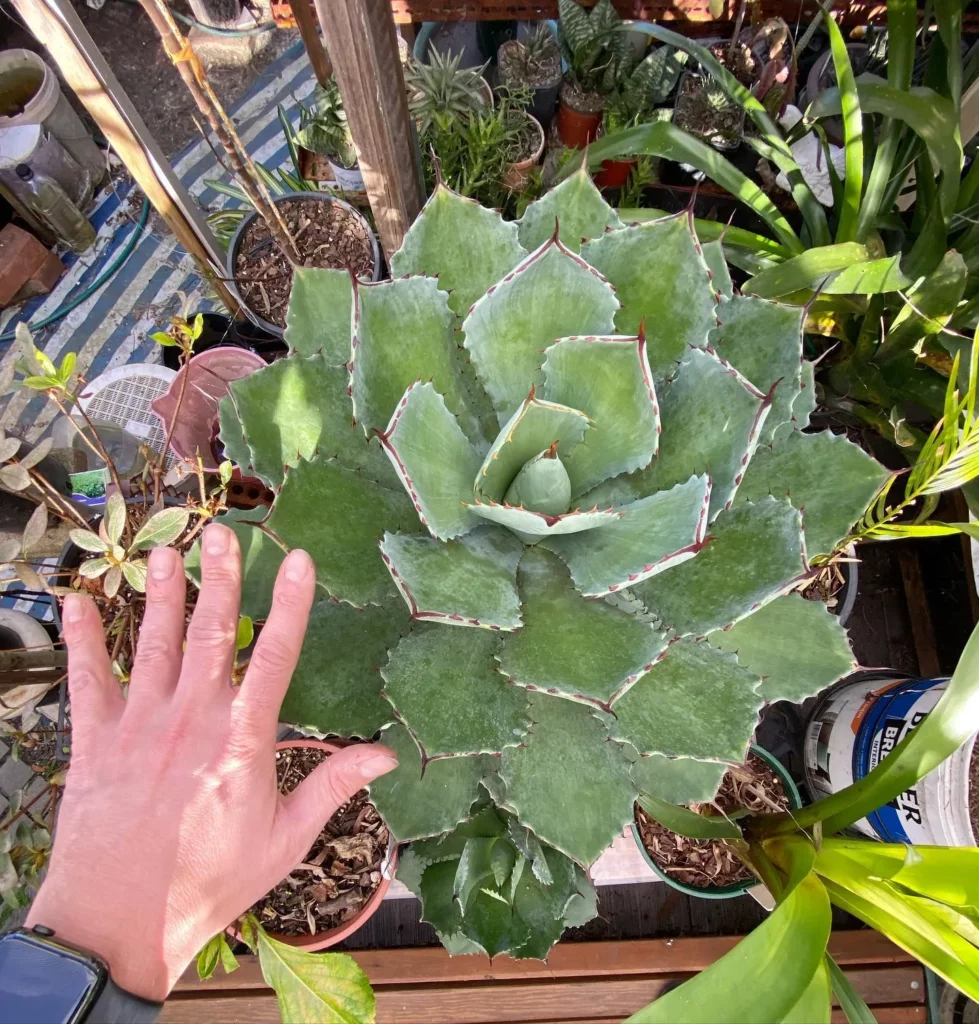
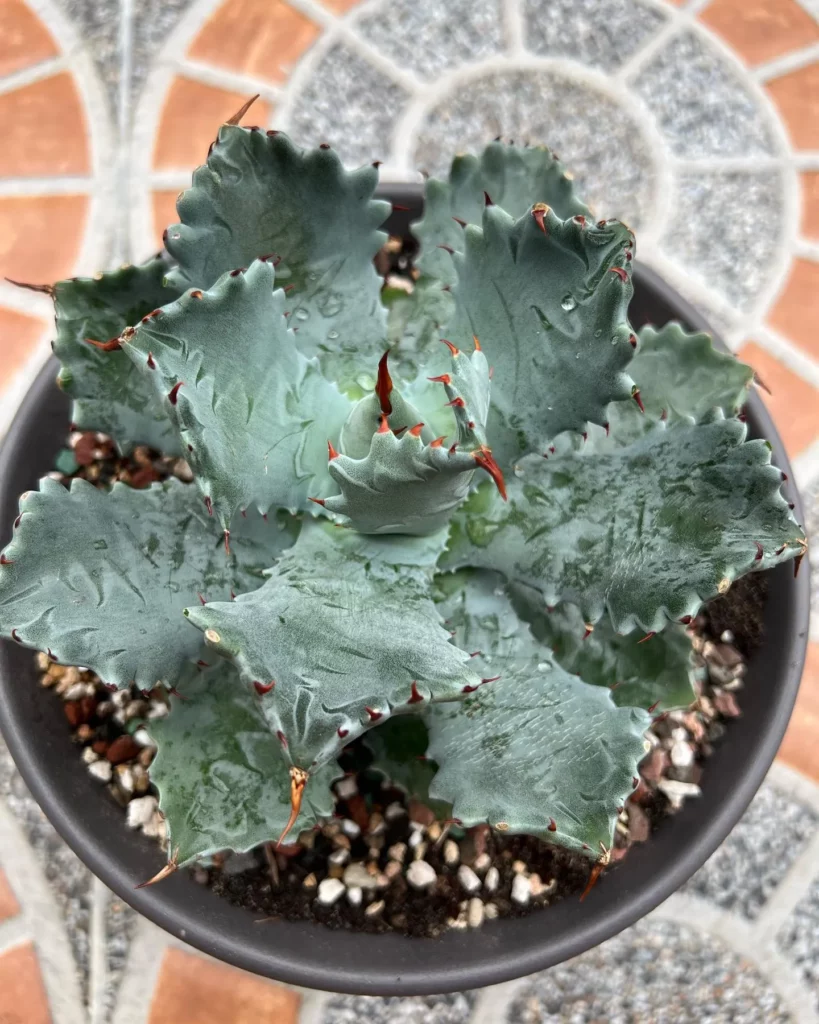
The Dwarf Butterfly Agave has specific light requirements that should be considered to ensure its optimal growth and health.
1. Filtered Sun or Full Shade: The Dwarf Butterfly Agave prefers to be placed in areas with filtered sun or full shade. While it can tolerate some morning sunlight, it should be protected from intense afternoon sun. Placing the agave in direct, full sun for extended periods can lead to sunburn and damage to the leaves.
2. Coastal Areas: This agave is well-suited for coastal regions with salty air and soils. It can thrive in these environments due to its salt tolerance. Coastal areas typically have milder temperatures and a higher amount of moisture in the air, which are favorable conditions for the Dwarf Butterfly Agave.
Additional Tips:
- Consider providing some shade during the hottest part of the day, especially in areas with intense sunlight.
- Monitor the agave’s response to the amount of light it receives. If the leaves start to show signs of discoloration or browning, it may be an indication that it is receiving too much direct sunlight.
- For indoor cultivation, place the Dwarf Butterfly Agave near a bright window where it can receive indirect sunlight.
Watering Requirements for Dwarf Butterfly Agave
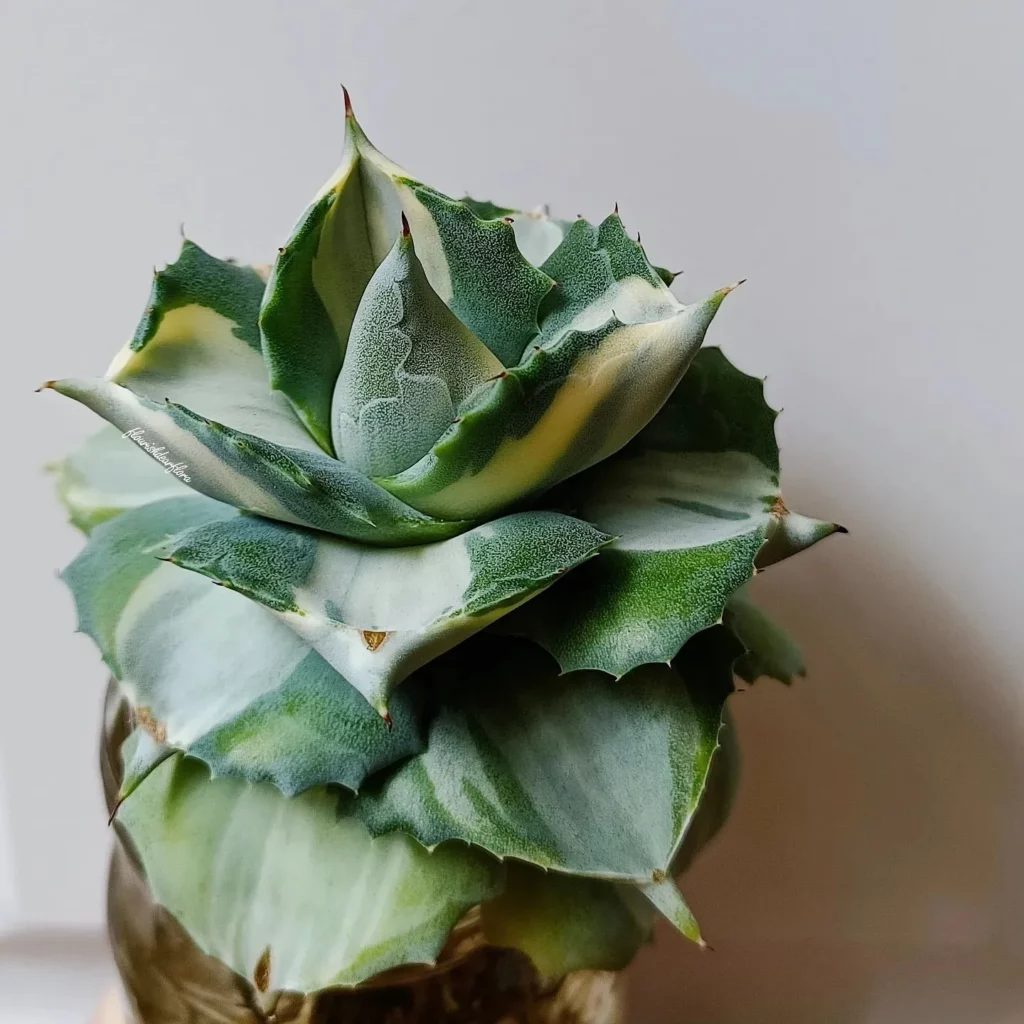
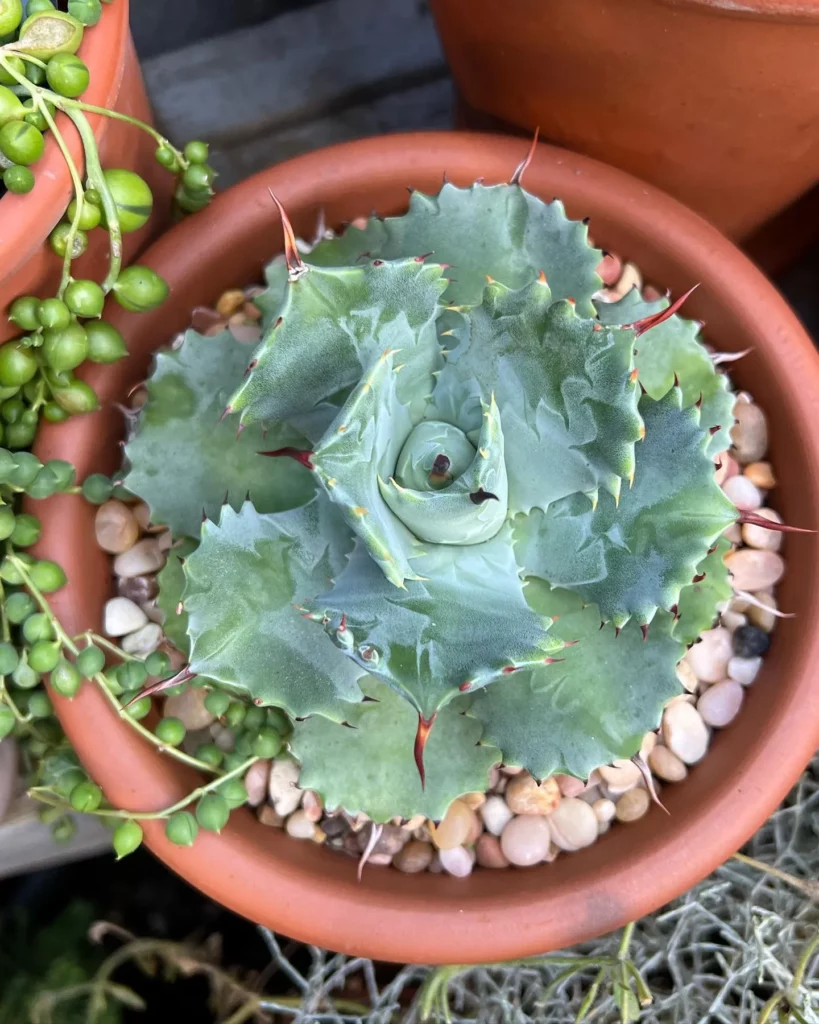
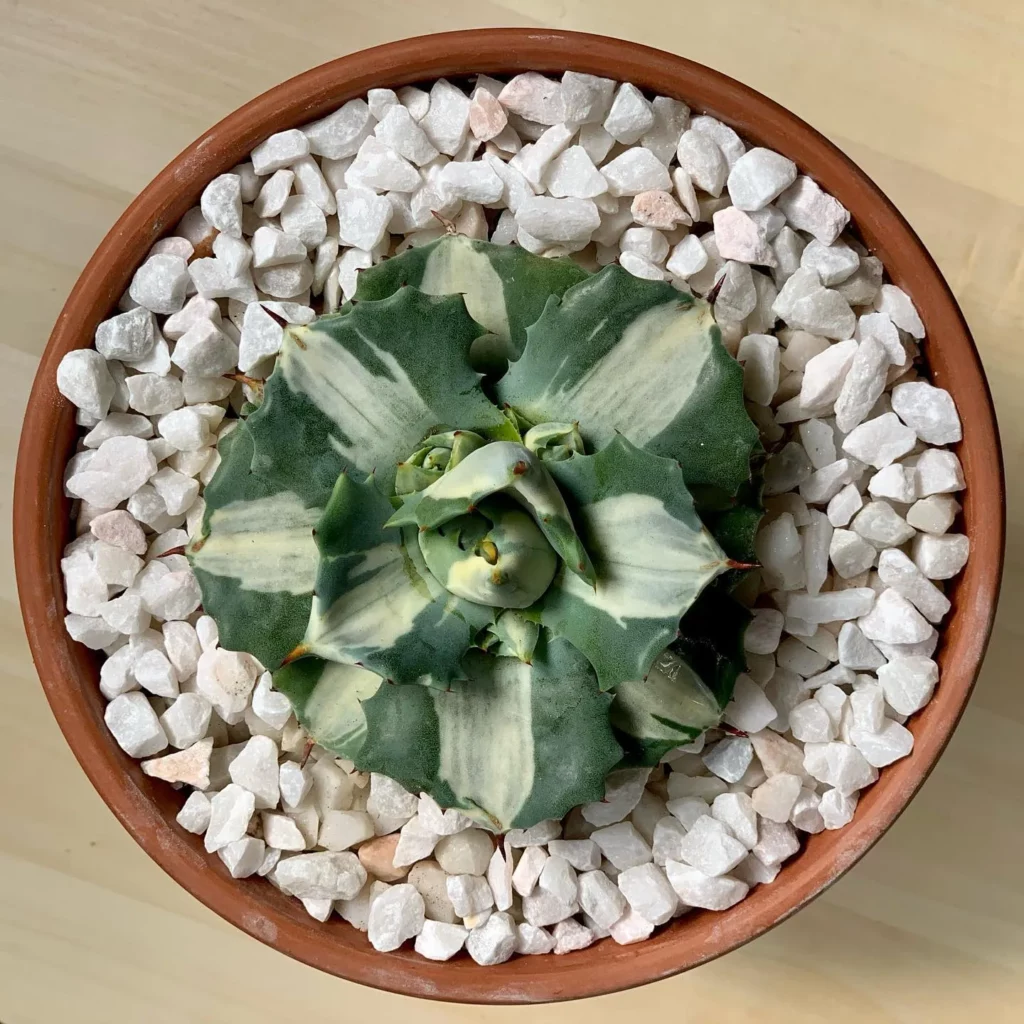
Proper watering is essential for the health and vitality of your Dwarf Butterfly Agave. While it is a drought-resistant plant, it still benefits from regular watering during the hot, dry season. However, it’s important to remember that this agave prefers to be watered infrequently and allowed to dry out between waterings.
When watering your Dwarf Butterfly Agave, make sure to thoroughly soak the soil to promote deep root growth. This will help the plant become more resilient to drought conditions. However, be cautious not to overwater, as excessive moisture can lead to root rot.
One way to determine if your agave needs watering is by checking the moisture level of the soil. Stick your finger about an inch into the soil, and if it feels dry, it’s time to water. Always aim to water at the base of the plant, avoiding wetting the leaves, as this can lead to fungal issues.
Few watering tips for your Dwarf Butterfly Agave:
- Water infrequently, allowing the soil to dry out between waterings.
- Thoroughly soak the soil when watering to promote deep root growth.
- Avoid overwatering, as it can lead to root rot.
- Check the moisture level of the soil by sticking your finger about an inch into the soil – if it feels dry, it’s time to water.
- Avoid wetting the leaves when watering to prevent fungal issues.
Fertilizing for Dwarf Butterfly Agave
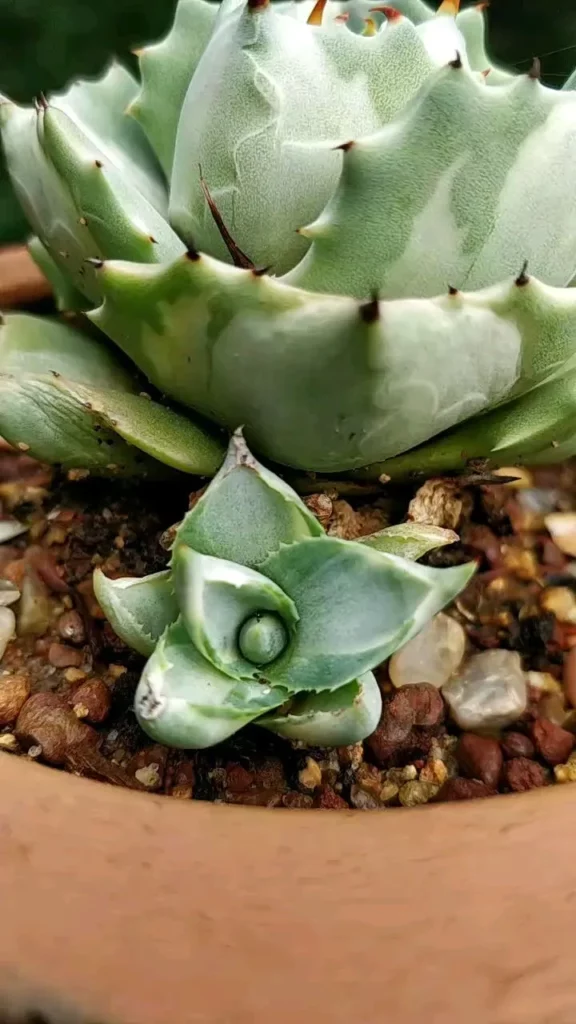
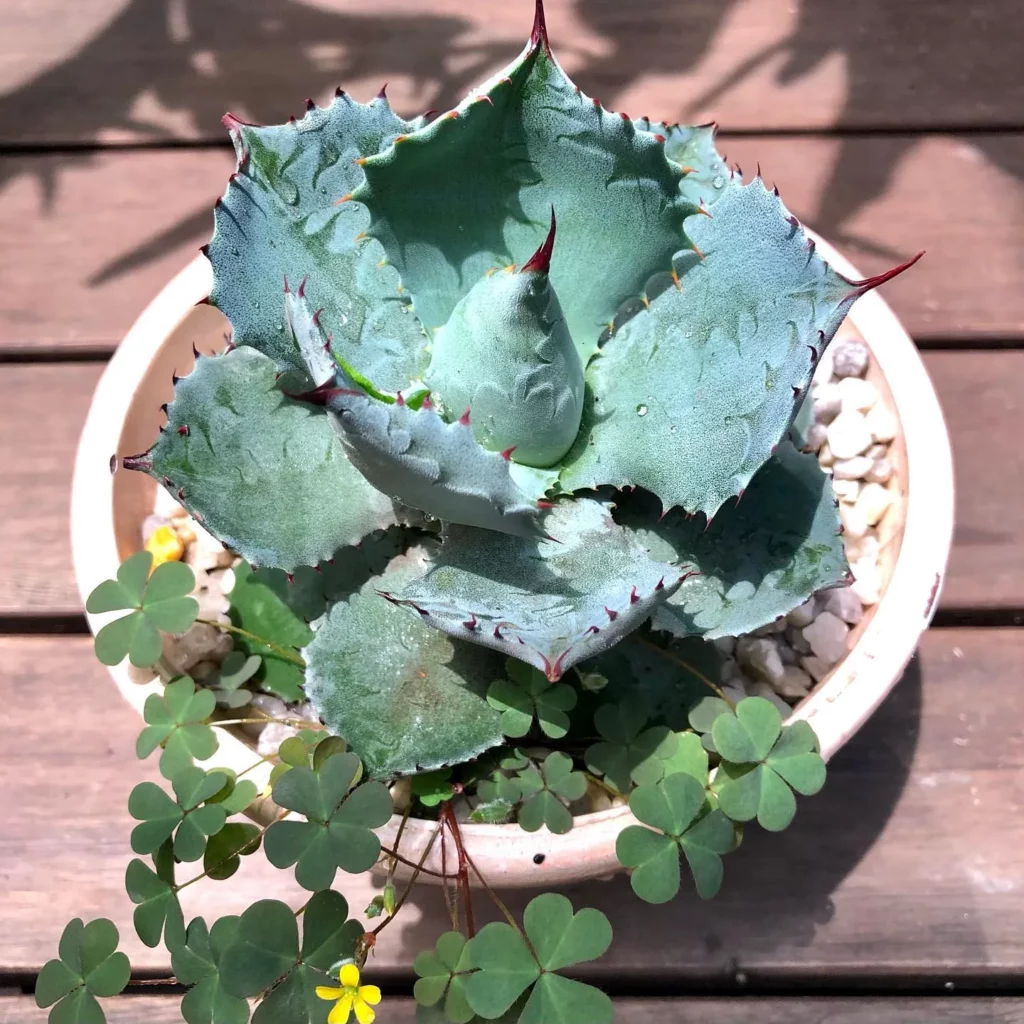
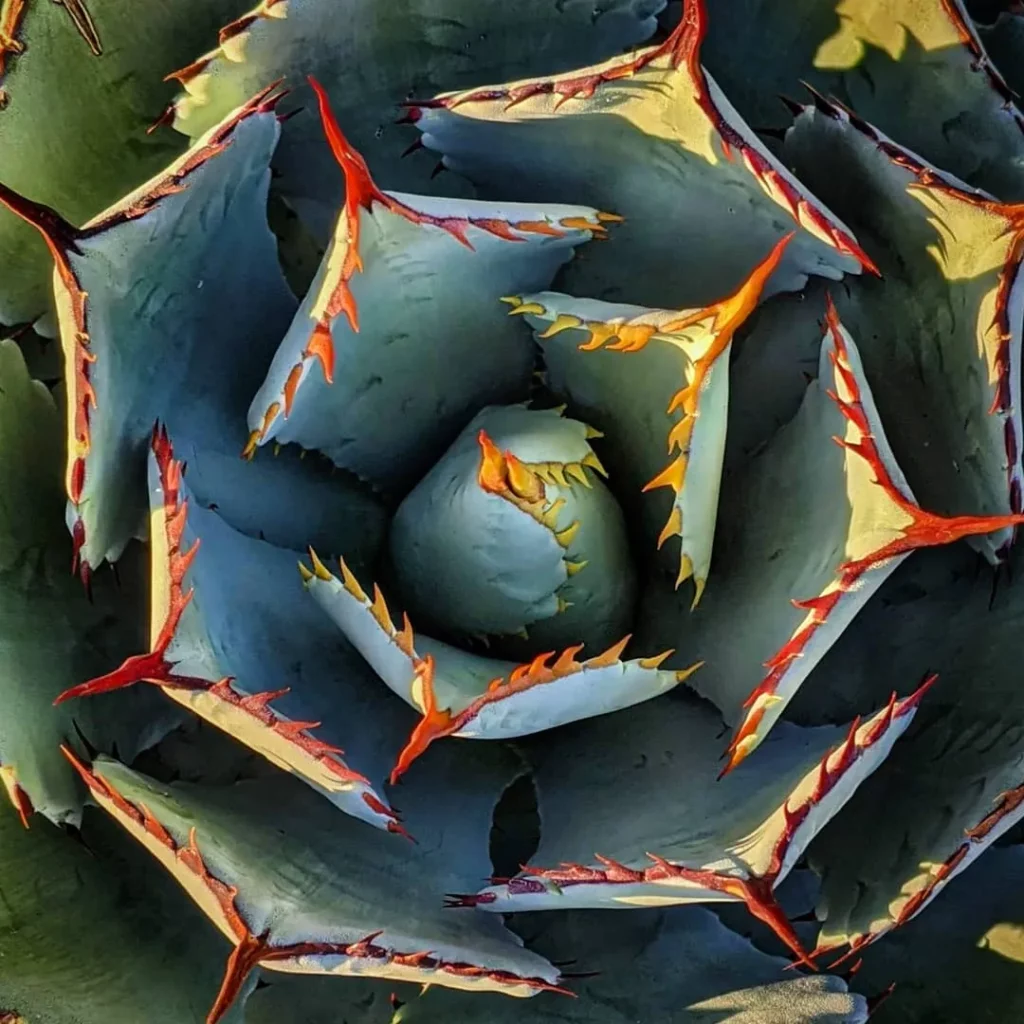
Fertilizing the Dwarf Butterfly Agave is important for maintaining its health and promoting optimal growth. However, it is crucial to avoid using fertilizers with heavy salts, as they can harm the plant. Here are some key points to keep in mind when fertilizing your Dwarf Butterfly Agave:
- Choose a balanced fertilizer: Use a slow-release, balanced fertilizer with an equal ratio of nitrogen, phosphorus, and potassium. This will provide the necessary nutrients for healthy growth and development.
- Apply fertilizer sparingly: The Dwarf Butterfly Agave does not require heavy fertilization. Apply the fertilizer sparingly, following the instructions on the packaging. Over-fertilization can lead to nutrient burn and damage the plant.
- Fertilize during the growing season: Fertilize your Dwarf Butterfly Agave during the active growing season, which is typically in spring and summer. This will help support its growth and replenish any nutrients that may have been depleted.
- Avoid fertilizing in winter: During the dormant period in winter, it is best to avoid fertilizing your Dwarf Butterfly Agave. This will allow the plant to rest and prepare for the next growing season.
Potting for Dwarf Butterfly Agave
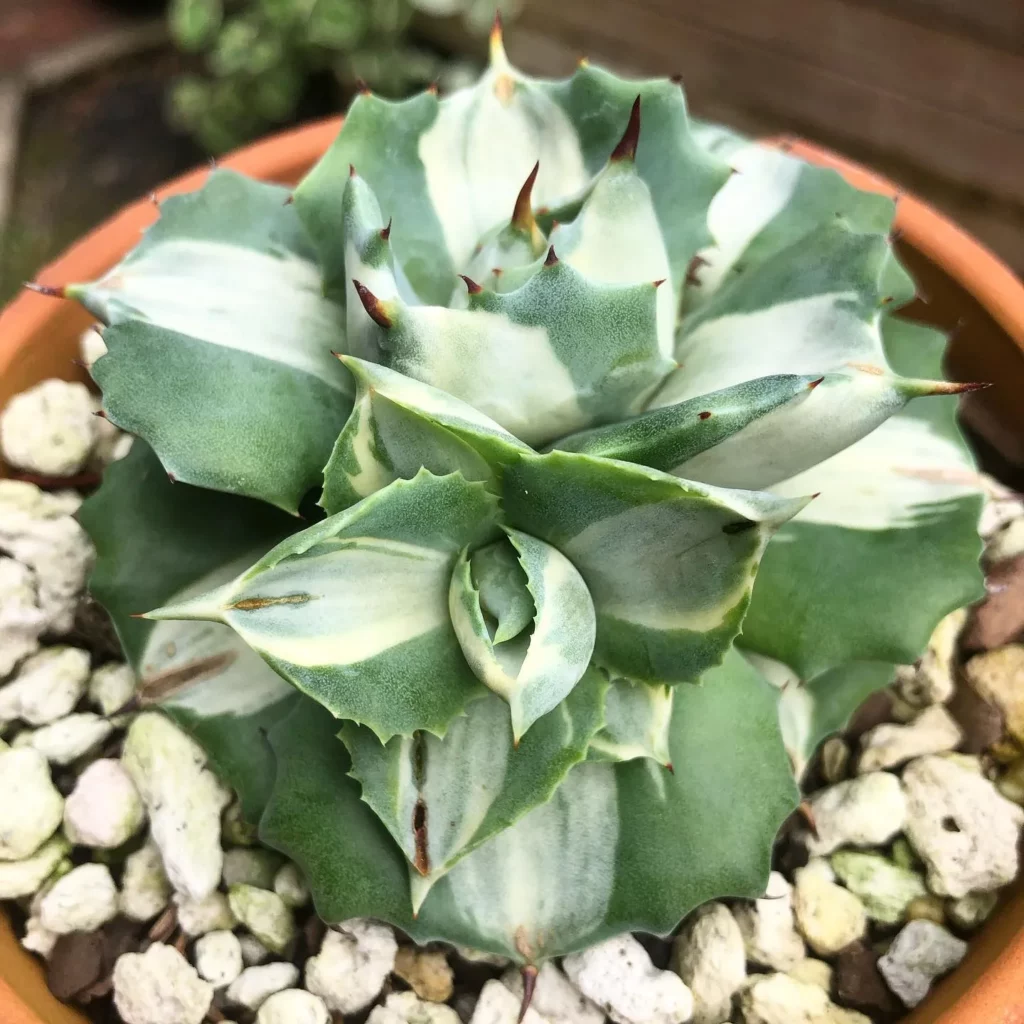
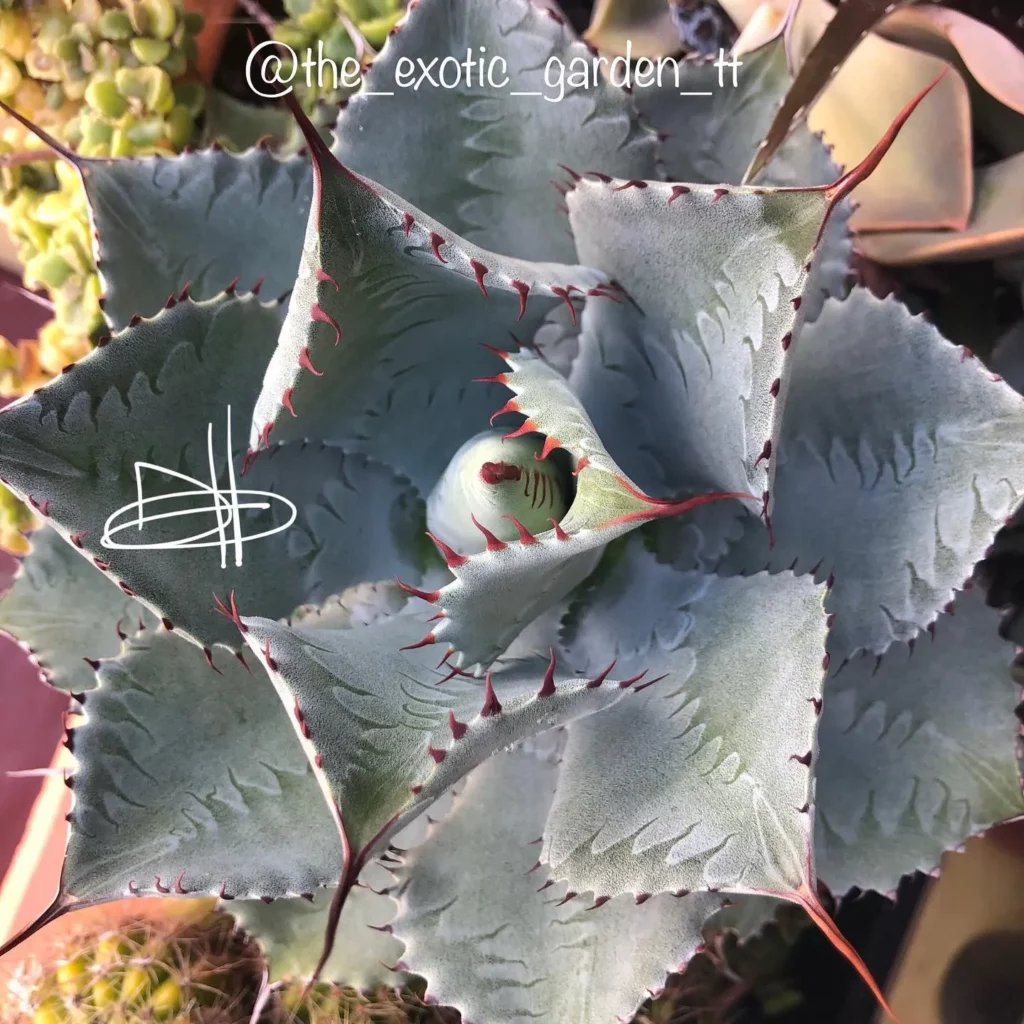
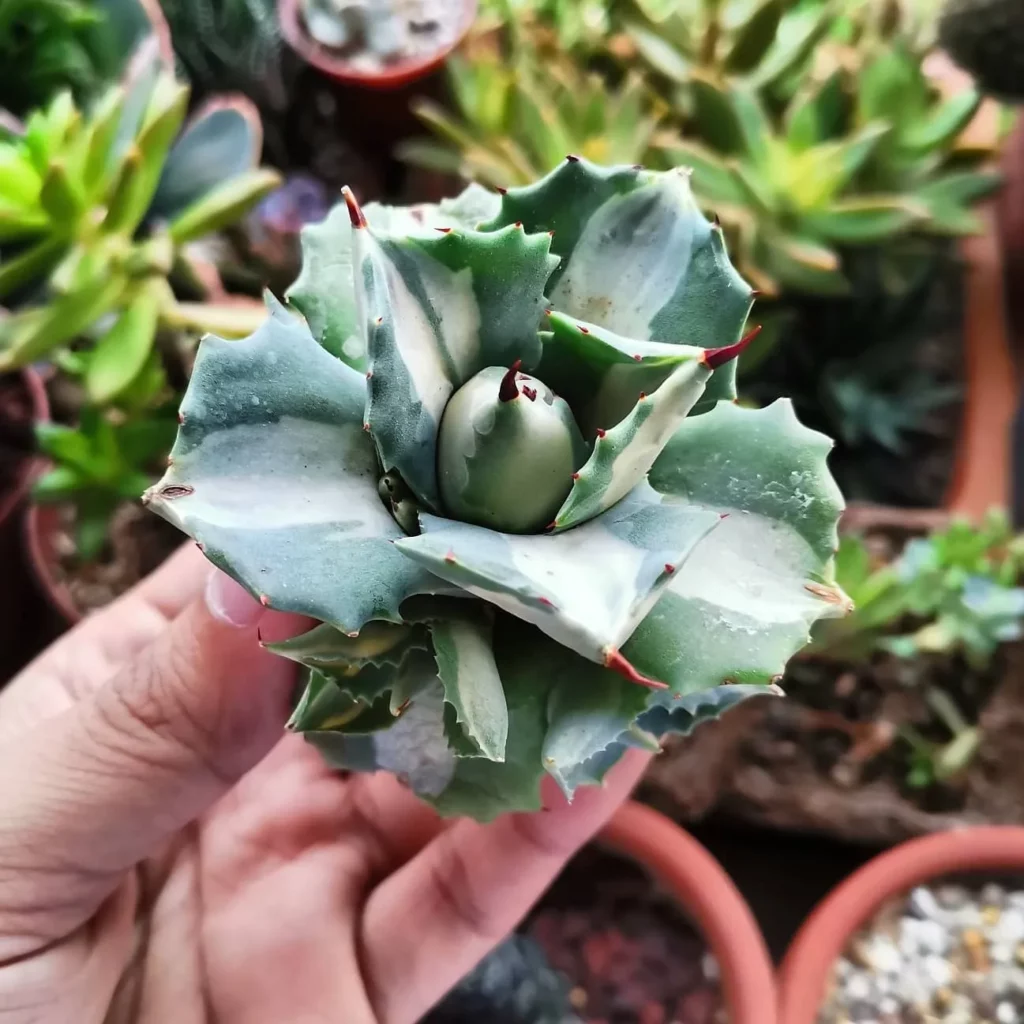
When it comes to potting your Dwarf Butterfly Agave, it’s important to choose the right soil and container to ensure its health and growth. Here are some key factors to consider:
1. Soil:
The Dwarf Butterfly Agave prefers well-draining soil to prevent root rot. Use an organic cactus mix that provides good airflow and drainage. Avoid using regular garden soil, as it tends to retain too much moisture and can lead to overwatering.
2. Container:
Since the Dwarf Butterfly Agave is a small plant, it is well-suited for growing in containers. Select a pot that allows for the plant’s roots to have some space to grow while still fitting snugly. Make sure the container has drainage holes at the bottom to prevent waterlogged soil.
3. Potting Process:
When potting your Dwarf Butterfly Agave, start by filling the container with the cactus mix. Gently remove the plant from its current pot, being careful not to damage the roots. Place the agave in the new container, ensuring that it sits at the same height as it did in the previous pot. Fill in the gaps with additional soil, pressing it down lightly to secure the plant.
Remember to water the newly potted agave sparingly and allow the soil to dry out between waterings. Overwatering can lead to root rot and other issues, so it’s best to err on the side of underwatering rather than overwatering.
Propagation of Dwarf Butterfly Agave
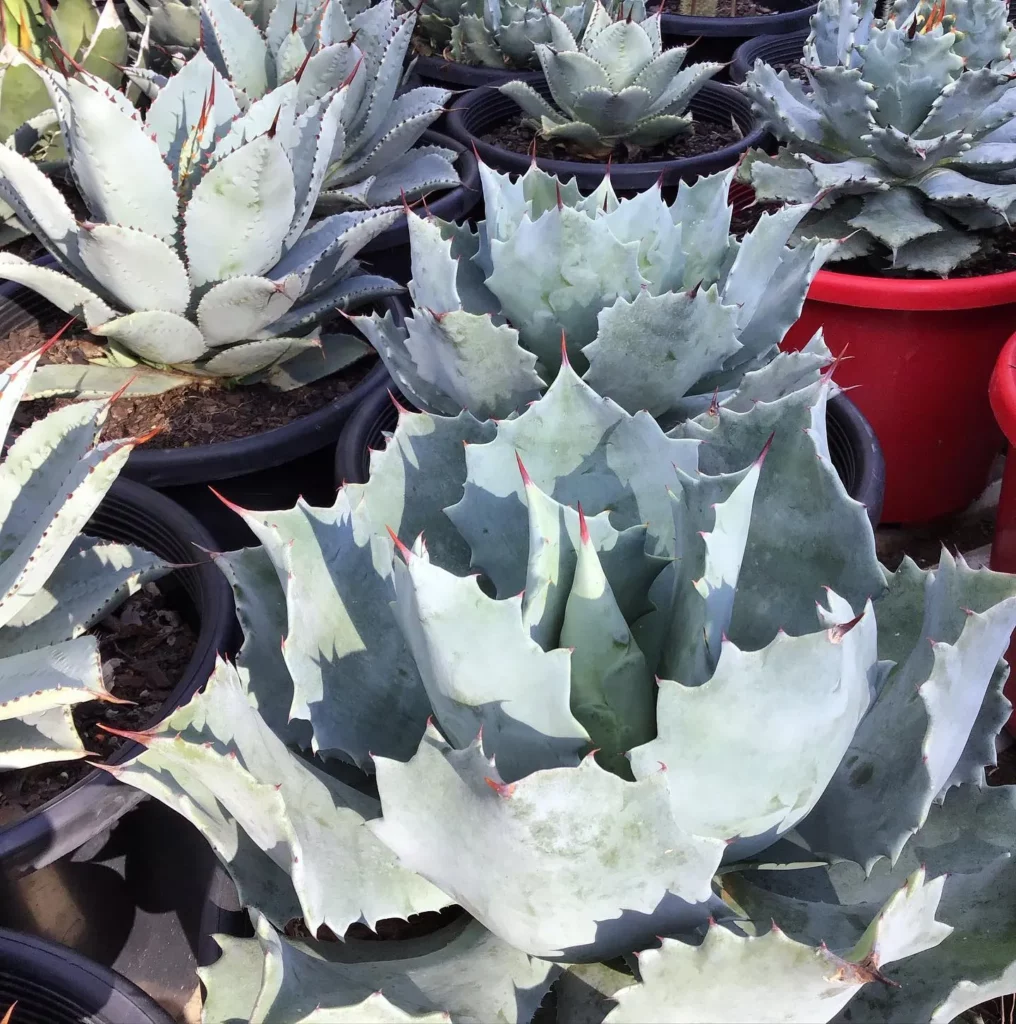
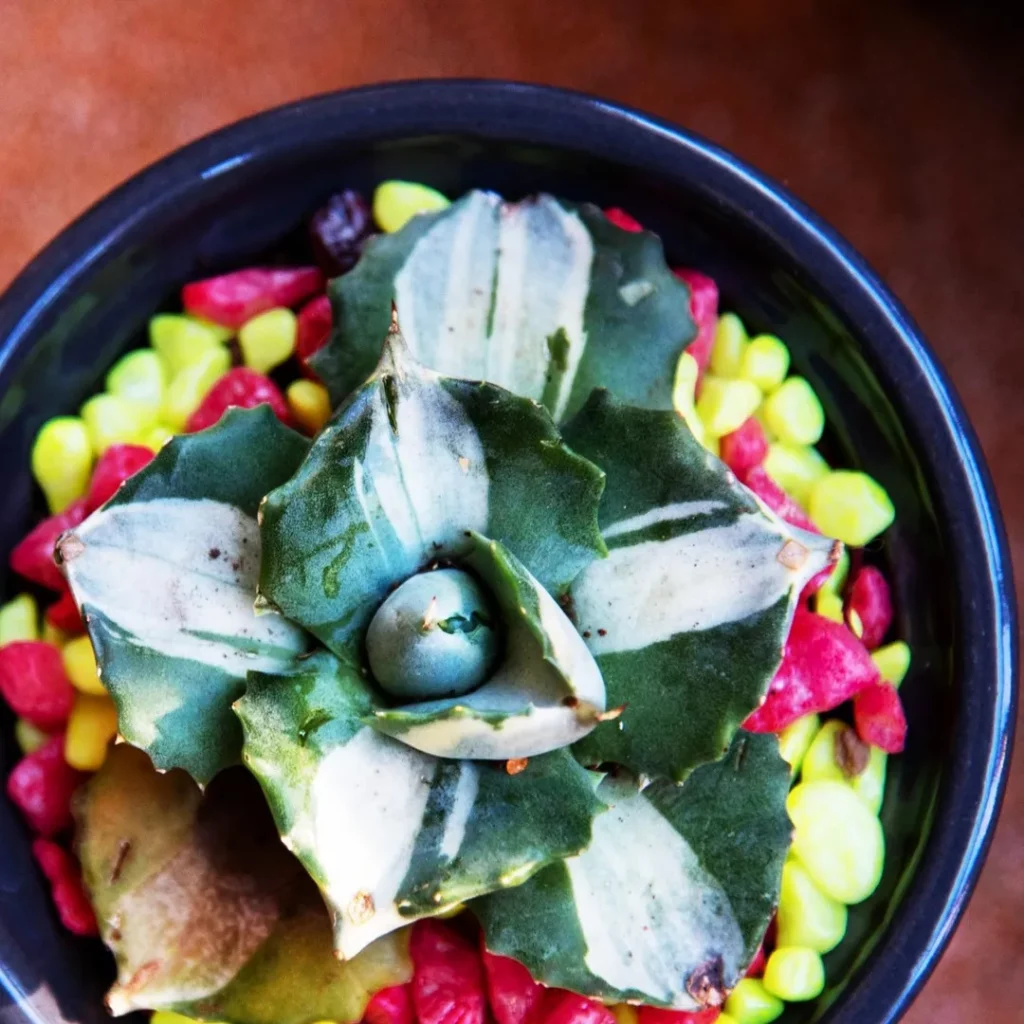
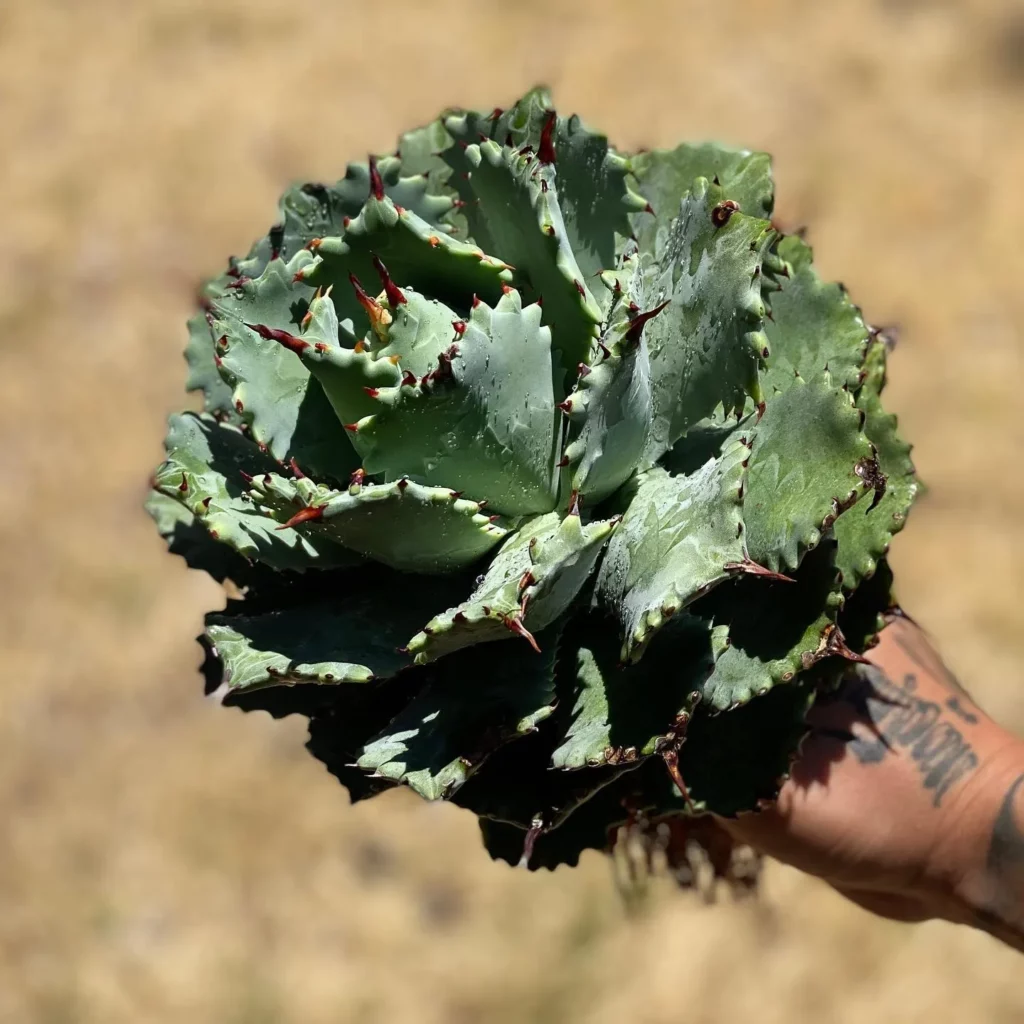
The Dwarf Butterfly Agave is a versatile plant that can be propagated through various methods. Here are some ways you can propagate this beautiful succulent:
- Offsets: The easiest and most common method of propagation is through offsets. These are small plantlets that grow around the base of the mother plant. Simply separate the offsets from the main plant using a clean, sharp knife or scissors. Allow the cut ends to dry for a few days before planting them in well-draining soil.
- Cuttings: Another method is through stem cuttings. Take a healthy stem from the mother plant and let it dry for a few days to form calluses. Once calluses have formed, plant the cuttings in a well-draining soil mix and keep them slightly moist until they root.
- Leaves: If you want to propagate the Dwarf Butterfly Agave from leaves, gently remove a healthy leaf from the mother plant. Allow the cut end to dry for a few days until calluses form. Then, place the callused end into a well-draining soil mix and keep it slightly moist. Roots will eventually develop, and a new plant will emerge.
- Seeds: Propagating from seeds requires more time and patience. Collect the seeds from mature flower stalks and sow them in a moist seed-starting mix. Keep the soil consistently moist and provide warmth and indirect light. It may take several weeks or even months for the seeds to germinate.
Repotting:
Once propagated, the Dwarf Butterfly Agave does not require frequent repotting. This plant prefers to be slightly root-bound, so only repot when necessary. When repotting, choose a container that is slightly larger than the current one and use a well-draining cactus mix. Be sure to gently loosen the roots before planting to encourage healthy growth.
Growth and Development of Dwarf Butterfly Agave
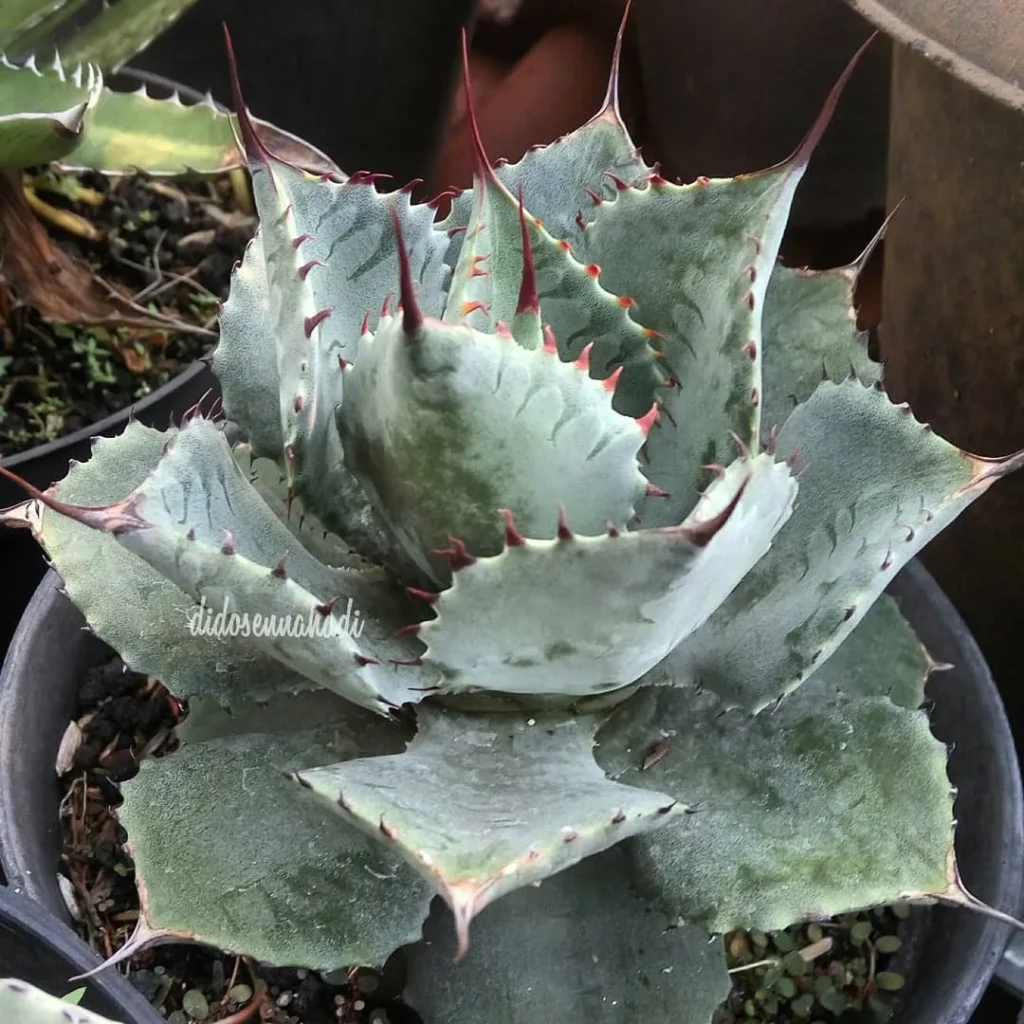
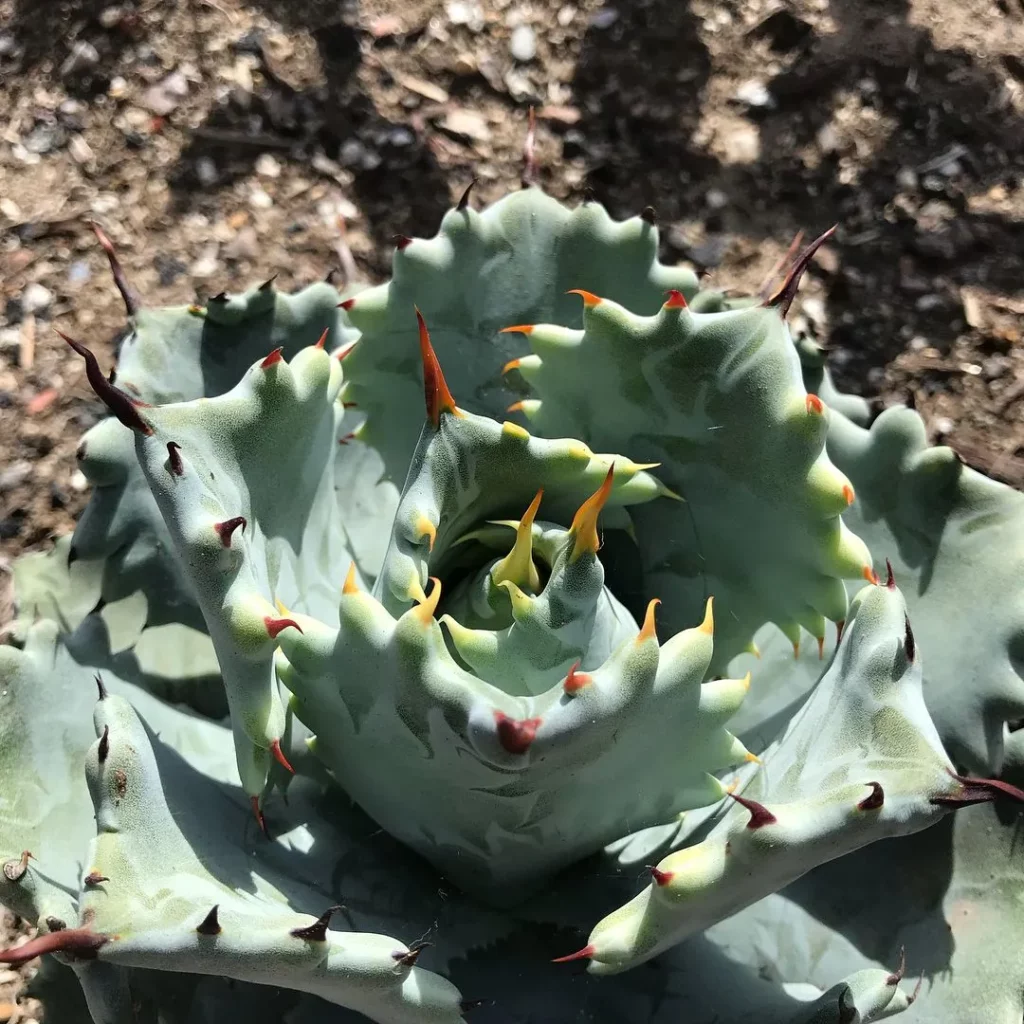
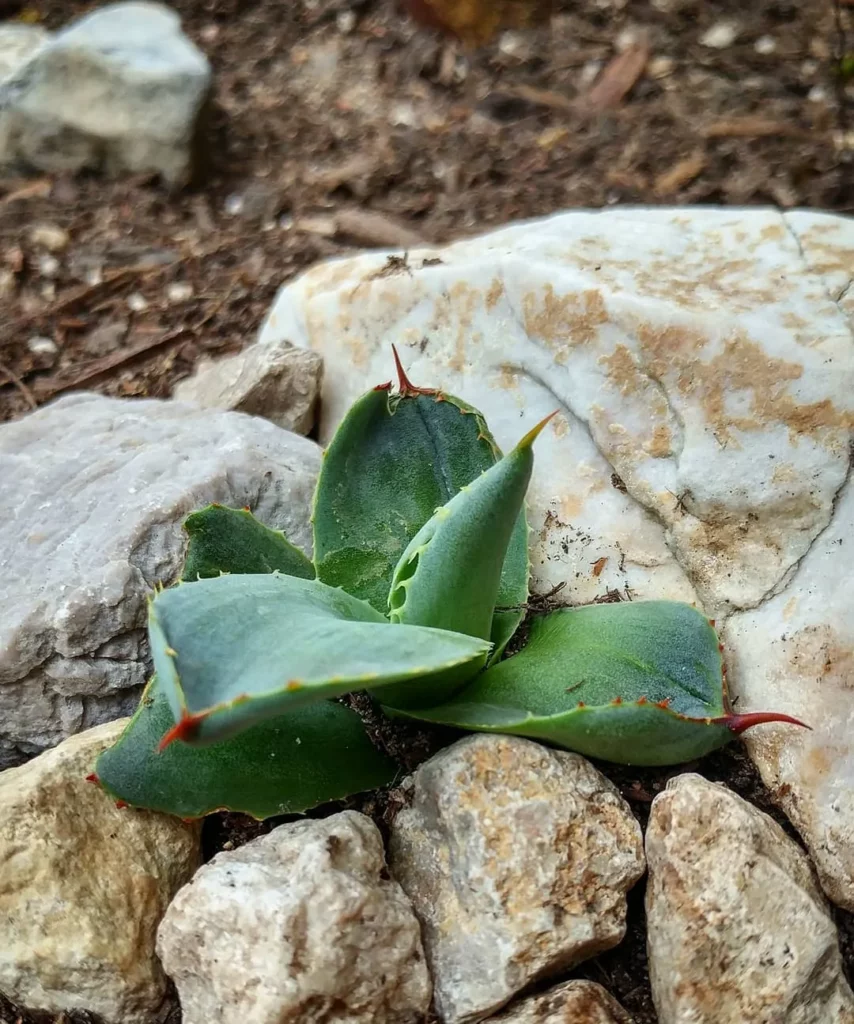
The Dwarf Butterfly Agave is a fast-growing plant that exhibits rapid development. With its small size and compact form, it reaches a maximum height of one foot, making it a perfect choice for those with limited gardening space. The agave produces numerous offsets that stay close to the mother plant, creating a lush and dense appearance.
One of the highlights of the Dwarf Butterfly Agave’s growth is its ability to develop a tall candelabra flower stalk at maturity. This stalk is adorned with beautiful yellow blooms, adding a touch of elegance to the overall aesthetic of the plant. The vibrant flowers attract pollinators, such as bees and butterflies, making it a delightful sight in any garden.
As the Dwarf Butterfly Agave grows, its powder blue leaves with prominent dark red teeth and a red terminal spine become more pronounced, enhancing the plant’s visual appeal. The compact rosette shape and narrow leaves that widen at the tips create an interesting and unique foliage arrangement. Overall, the growth and development of the Dwarf Butterfly Agave contribute to its charm and make it a sought-after addition to any landscape.
Pests and Diseases of Dwarf Butterfly Agave
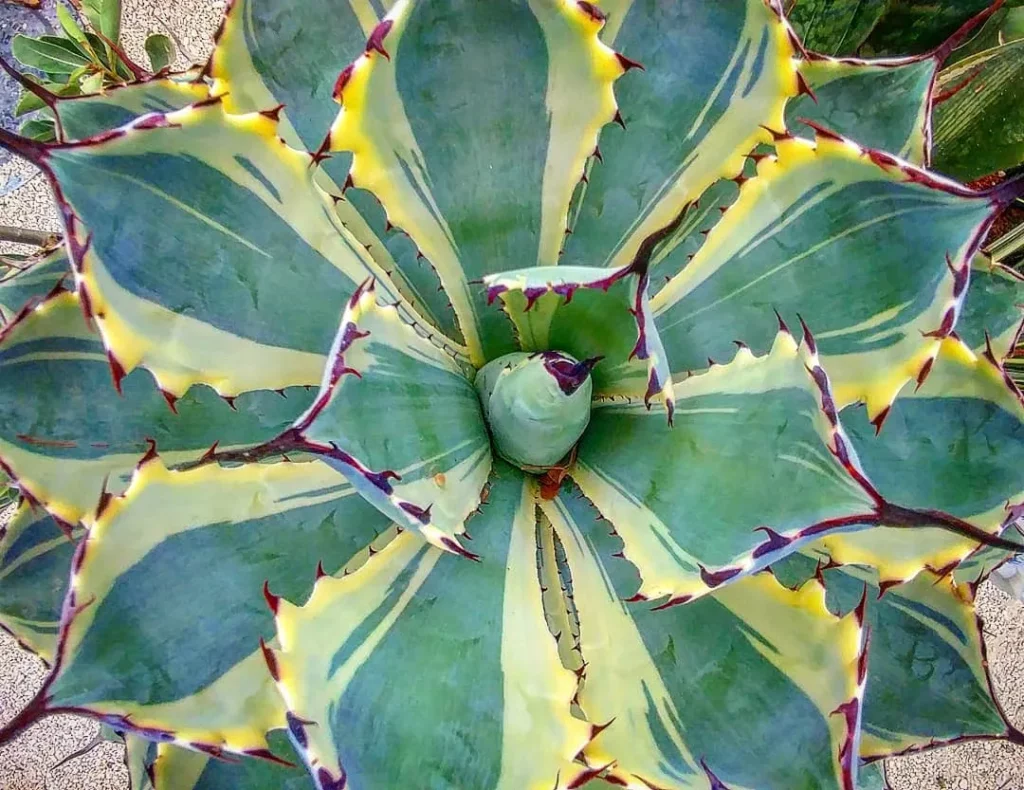
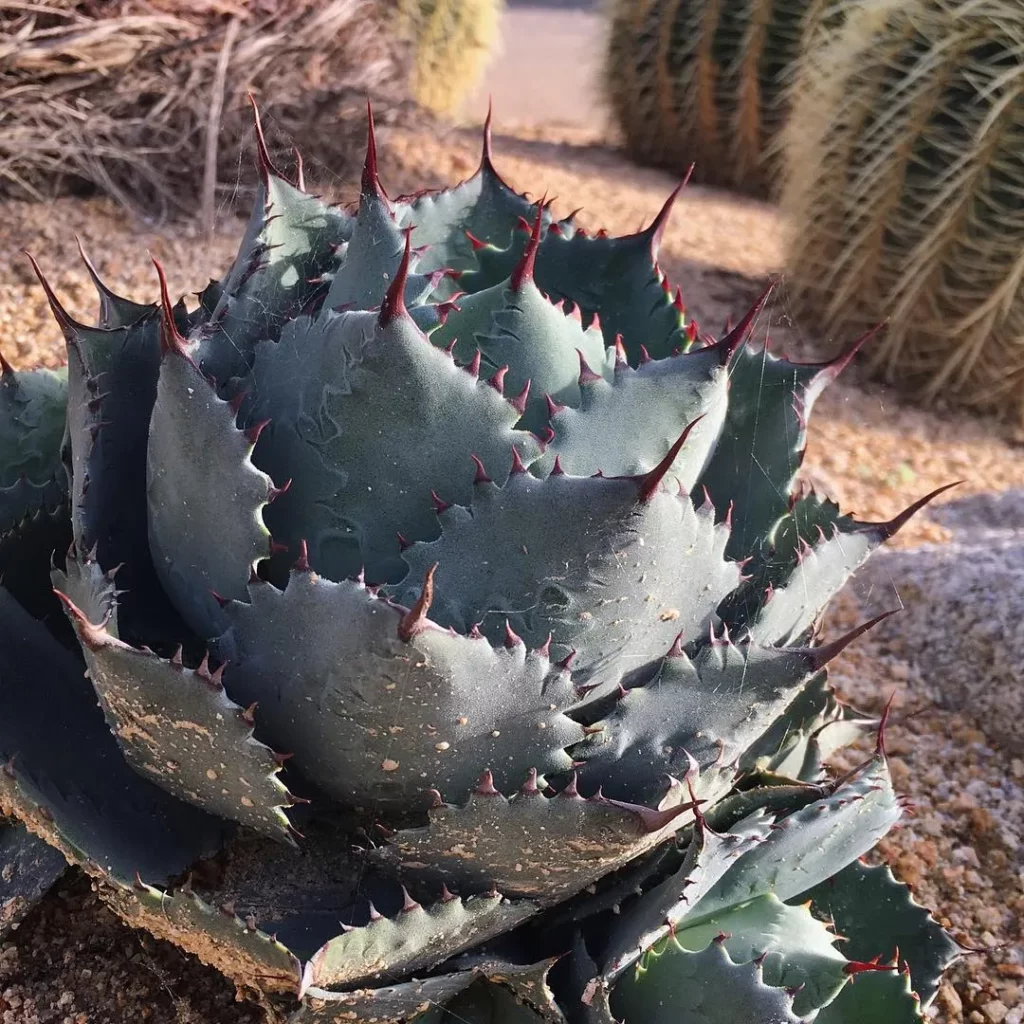
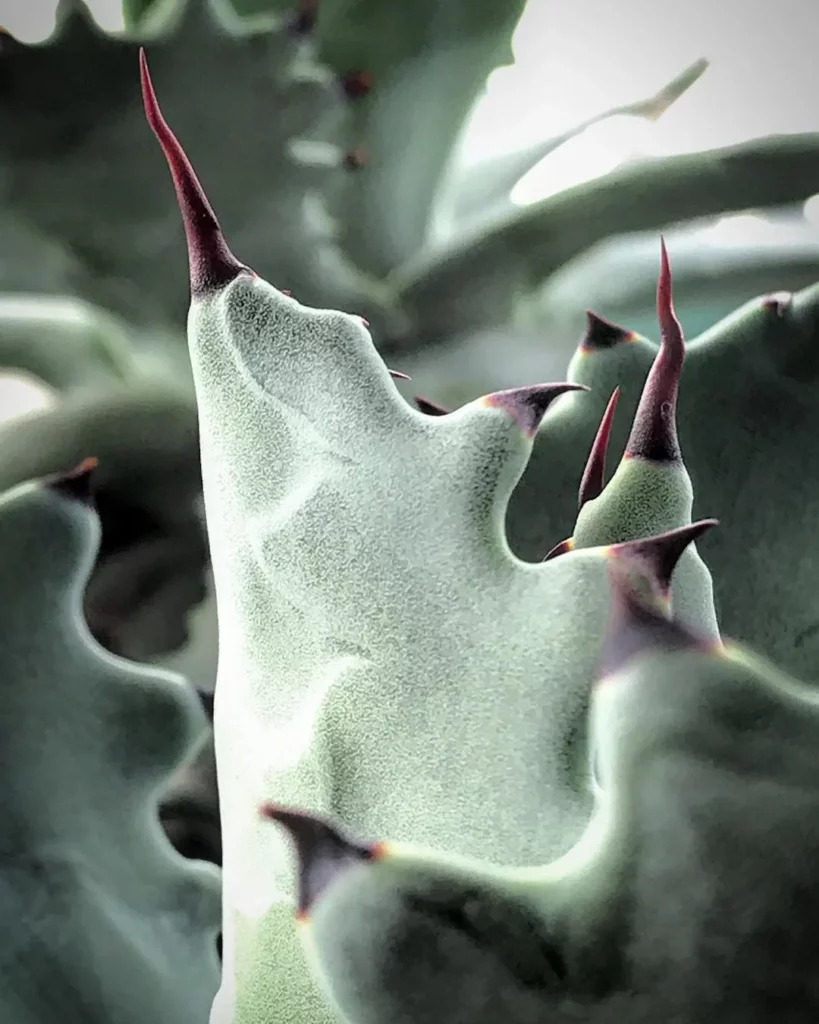
Growing the Dwarf Butterfly Agave is generally an easy and low-maintenance experience. However, like any plant, it can be susceptible to certain pests and diseases. By understanding and taking preventative measures, you can keep your Dwarf Butterfly Agave healthy and thriving.
Pests:
- Mealybugs: These tiny white insects can infest the leaves and stems of the agave, causing damage and weakening the plant. Regularly inspect your agave for signs of mealybugs and treat them promptly with insecticidal soap or a neem oil solution.
- Scale Insects: These small insects attach themselves to the leaves and suck out the plant’s sap, leading to yellowing and wilting. Use a soft brush or cotton swab dipped in rubbing alcohol to remove them manually, or use an insecticidal soap to control their population.
Diseases:
- Root Rot: Overwatering or poorly draining soil can lead to root rot in the Dwarf Butterfly Agave. To prevent this, ensure that the soil is well-draining and allow it to dry out between waterings. If you notice signs of root rot, such as mushy or blackened roots, it’s important to take immediate action by cutting away the affected areas and repotting the agave in fresh, well-draining soil.
- Fungal Diseases: Excessive moisture, high humidity, or poor air circulation can create favorable conditions for fungal diseases such as leaf spot or powdery mildew. To prevent these issues, avoid overhead watering, provide good airflow around the plant, and treat any signs of fungal growth with a suitable fungicide.
Conclusion
By following the care guide provided, you can easily cultivate and enjoy the beauty of the Dwarf Butterfly Agave. This miniature plant thrives in small beds, cactus and succulent gardens, rock gardens, and mixed planters with other low-water-use plants. It is well-suited for coastal regions with salty air and soils, making it a versatile choice for a range of environments.
With its narrow powder blue leaves, dark red teeth, and red terminal spine, the Dwarf Butterfly Agave is sure to catch the eye. Its fast growth rate and ability to produce many offsets ensure that you will have a beautiful display in no time. Additionally, its resistance to pests and diseases, though susceptible to common succulent pests such as mealybugs and scale insects, make it a low-maintenance option.
Whether you’re a gardening enthusiast or someone looking to add a touch of natural beauty to your space, the Dwarf Butterfly Agave is a fantastic choice. Embrace its unique characteristics and follow the care guide, and you’ll be rewarded with a thriving and stunning plant that will bring joy for years to come.
FAQ
What is the appearance of the Dwarf Butterfly Agave?
The Dwarf Butterfly Agave is a miniature, compact plant that grows to one foot tall and wide. It has powder blue leaves with prominent dark red teeth and a red terminal spine. At maturity, it develops a tall candelabra flower stalk with yellow blooms.
What are the light requirements for the Dwarf Butterfly Agave?
The Dwarf Butterfly Agave prefers filtered sun or full shade conditions. It can tolerate morning sunlight but should be protected from hot, afternoon sun. It grows well along the coast and is tolerant of salty air and soils.
How often should I water the Dwarf Butterfly Agave?
The Dwarf Butterfly Agave is drought-resistant but benefits from supplemental irrigation during the hot, dry season. It should be watered infrequently and allowed to dry out between waterings. It prefers well-draining soil to prevent root rot.
How often should I fertilize the Dwarf Butterfly Agave?
The Dwarf Butterfly Agave does not require heavy fertilization. It can be fed triannually with a balanced fertilizer, but care should be taken to avoid fertilizers with heavy salts.
Can the Dwarf Butterfly Agave be grown in containers?
Yes, the Dwarf Butterfly Agave can be grown in containers due to its small size and compact form. It prefers well-draining soil and should be potted in an organic cactus mix. Care should be taken to avoid wet or mucky soil.
How can I propagate the Dwarf Butterfly Agave?
The Dwarf Butterfly Agave can be propagated through offsets, cuttings, leaves, or seeds. It is recommended to use the offset method, as it is less time-consuming. Repotting is not required frequently.
How tall does the Dwarf Butterfly Agave grow?
The Dwarf Butterfly Agave has a fast growth rate and reaches a maximum height of one foot. It produces many offsets that stay close to the mother plant. The agave can develop a tall candelabra flower stalk with yellow blooms at maturity.
Is the Dwarf Butterfly Agave resistant to pests and diseases?
The Dwarf Butterfly Agave is generally resistant to pests and diseases. However, it can be susceptible to common succulent pests such as mealybugs and scale insects. Proper care and maintenance, including ensuring good airflow and avoiding overwatering, can help prevent pest and disease issues.

